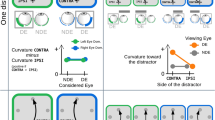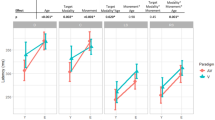Abstract
Saccadic peak velocities during monocular and binocular presentation were tested. While the main sequence linear increase in peak velocities as a function of saccade amplitude is well documented, our results provide demonstrations of violations of the main sequence. Peak velocities during monocular presentation were considerably higher toward temporal than nasal stimuli. This nasal–temporal asymmetry (NTA) was not explained by amplitude differences and was most pronounced for the lowest amplitudes tested, decreasing with increased amplitude. Under binocular presentation, this NTA was much smaller. While the exact reasons for this difference in peak velocities between hemifields are unclear at present, we propose that anatomical NTAs result in stronger signals from the nasal, than temporal retina leading to higher peak velocities into the temporal visual hemifield. NTAs in peak velocity are consistent with NTAs in attentional choice and in attentional function, which might also be explained by anatomical NTA.



Similar content being viewed by others
Notes
In experiments 1 and 2 in Jóhannesson et al. (2012), a very different task involving interleaved centripetal, centrifugal, abducting, and adducting saccades was used, so data from those experiments are not included here.
Exogenous attention and discrimination tasks will not be further discussed here since they are irrelevant to the current topic.
Caution is needed for predictions of PV values at the outermost points in the graphs since they represent relatively few data points, especially for the higher amplitudes (toward the right of the graphs).
The regression equation for the chosen model is: y = intercept + amplitudeSlope × amplitude + hemifieldSlope × hemifield + interactionSlope × amplitude × hemifield. To take an example a calculation for 5° amplitude and a saccade into the temporal hemifield yields: 187.2 + 19.8 × 5 + 47.8 × 1 + (−7.7 × 5 × 1) = 295.5°/s.
References
Akaike H (1974) A new look at the statistical model identification. IEEE Trans Autom Control 19:716–723
Baayen RH, Davidson DJ, Bates DM (2008) Mixed-effects modeling with crossed random effects for subjects and items. J Mem Lang 59:390–412. doi:10.1016/j.jml.2007.12.005
Bahill A, Clark M, Stark L (1975) The main sequence, a tool for studying human eye movements. Math Biosci 24:191–204
Bates D (2010) lme4: mixed-effects modelling with R. http://lme4.r-forge.r-project.org/book/
Becker W (1991) Saccades. In: Carpenter RHS (ed) Vision and visual dysfunction: vol 8, Eye movements. CRC, Boca Raton, pp 95–137
Beydagi H, Yilmaz A, Süer C (1999) The effect of direction on saccadic eye movement parameters. J Basic Clin Physiol Pharmacol 10:73–77
Boghen D, Troost B, Daroff RB et al (1974) Velocity characteristics of normal human saccades. Investig Ophthalmol Vis Sci 13:619–623
Bompas A, Sterling T, Rafal RD, Sumner P (2008) Naso-temporal asymmetry for signals invisible to the retinotectal pathway. J Neurophysiol 100(1):412–421
Burnham K, Anderson DR (2004) Multimodel inference understanding AIC and BIC in model selection. Sociol Methods Res 33:261–304
Cambridge Research Systems (2006) Video eyetracker toolbox, user manual. Cambridge Research Systems, Rochester
Collewijn H, Erkelens C, Steinman R (1988) Binocular co-ordination of human horizontal saccadic eye movements. J Physiol 404(1):157–182
Cullen KE, Van Horn MR (2011) Brainstem pathways and premotor control. In: Liversedge L, Gilchrist ID, Everling S (eds) Oxford handbook of eye movements. Oxford University Press, Oxford, pp 151–172
Curcio CA, Allen KA (1990) Topography of ganglion cells in human retina. J Comp Neurol 300(1):5–25
Deubel H, Schneider WX (1996) Saccade target selection and object recognition: evidence for a common attentional mechanism. Vis Res 36(12):1827–1837
Dixon P (2008) Models of accuracy in repeated-measures designs. J Mem Lang 59:447–456
Dodds C, Machado L, Rafal R, Ro T (2002) A temporal/nasal asymmetry for blindsight in a localisation task: evidence for extrageniculate mediation. NeuroReport 13(5):655–658
Doubell TP, Skaliora I, Baron J, King AJ (2003) Functional connectivity between the superficial and deeper layers of the superior colliculus: an anatomical substrate for sensorimotor integration. J Neurosci 23(16):6596–6607
Fahle M, Schmid M (1988) Naso-temporal asymmetry of visual perception and of the visual cortex. Vis Res 28(2):293–300
Fricker SJ (1971) Dynamic measurements of horizontal eye motion I. Acceleration and velocity matrices. Invest Ophthalmol Vis Sci 10:724–732
Furuya N, Yabe T, Chiba Y (1986) Predominance of nasal over temporal saccades in fast eye movement. Auris Nasus Larynx (Tokyo) 13:53–62
Greenberg G (1960) Eye-dominance and head-tilt. Am J Psychol 73(1):149–151
Hoffman JE, Subramaniam B (1995) The role of visual attention in saccadic eye movements. Percep Psychophys 57(6):787–795
Honda H (2002) Idiosyncratic left-right asymmetries of saccadic latencies: examination in a gap paradigm. Vis Res 42:1437–1445
Hubel D, LeVay S, Wiesel T (1975) Mode of termination of retinotectal fibers in macaque monkey: an autoradiographic study. Brain Res 96(1):25–40
Itaya SK, Van Hoesen GW (1983) Retinal projections to the inferior and medial pulvinar nuclei in the old-world monkey. Brain Res 269(2):223–230
Jóhannesson ÓI, Ásgeirsson ÁG, Kristjánsson Á (2012) Saccade performance in the nasal and temporal hemifields. Exp Brain Res 219(1):107–120. doi:10.1007/s00221-012-3071-2
Johnston K, Everling S (2011) Frontal cortex and flexible control of saccades. In: Liversedge L, Gilchrist ID, Everling S (eds) Oxford handbook of eye movements. Oxford University Press, Oxford, pp 279–302
Kowler E, Anderson E, Dosher B, Blaser E (1995) The role of attention in the programming of saccades. Vis Res 35(13):1897–1916
Kristjánsson Á (2007) Saccade landing point selection and the competition account of pro- and antisaccade generation: the involvement of visual attention? A review. Scand J Psychol 48:97–113. doi:10.1111/j.1467-9450.2007.00537.x
Kristjánsson Á (2009) Learning in shifts of transient attention improves recognition of parts of ambiguous figure-ground displays. J Vis 9(4):1–11
Kristjánsson Á (2011) The intriguing interactive relationship between visual attention and saccadic eye movements. In: Liversedge L, Gilchrist ID, Everling S (eds) Oxford handbook of eye movements. Oxford University Press, Oxford, pp 455–470
Kristjansson A, Nakayama K (2003) A primitive memory system for the deployment of transient attention. Percep Psychophys 65:711–724
Kristjansson A, Chen Y, Nakayama K (2001) Less attention is more in the preparation of antisaccades, but not prosaccades. Nat Neurosci 4(10):1037–1042
Kristjansson A, Vandenbroucke M, Driver J (2004) When pros become cons for anti-versus prosaccades: factors with opposite or common effects on different saccade types. Exp Brain Res 155(2):231–244
Kustov AA, Robinson DL (1996) Shared neural control of attentional shifts and eye movements. Nature 384:74–77
Leigh R, Zee D (2006) The neurology of eye movements. Oxford University Press, Oxford
Posner MI, Cohen Y (1980) Attention and control of movements. In: Stelmach GE, Region J (eds) Tutorials in motor behavior. North Holland Publishing, Amsterdam, pp 243–258
Rafal R, Calabresi P, Brennan C, Sciolto T (1989) Saccade preparation inhibits reorienting to recently attended locations. J Exp Psychol Hum Percep Perform 15(4):673–685
Rafal RD, Henik A, Smith J (1991) Extrageniculate contributions to reflex visual orienting in normal humans: a temporal hemifield advantage. J Cogn Neurosci 3(4):322–328
Robinson DA (1964) The mechanics of human saccadic eye movement. J Physiol 174:245–264
Rohrschneider K (2004) Determination of the location of the fovea on the fundus. Invest Ophthalmol Vis Sci 45(9):3257–3258. doi:10.1167/iovs.03-1157
Rolfs M, Vitu F (2007) On the limited role of target onset in the gap task: support for the motor-preparation hypothesis. J Vis 7(10):1–20. doi:10.1167/7.10.7
Sparks DL (2002) The brainstem control of saccadic eye movements. Nature Rev Neurosci 3:952–964
Sterling P (1973) Quantitative mapping with the electron microscope: retinal terminals in the superior colliculus. Brain Res 54:347–354
Tigges J, Tigges M (1981) Distribution of retionfugal and corticofugal axon terminals in the superior colliculus of squirrel monkey. Invest Ophthalmol Vis Sci 20:149–158
Tomalski P, Johnson MH, Csibra G (2009) Temporal-nasal asymmetry of rapid orienting to face-like stimuli. NeuroReport 20(15):1309–1312. doi:10.1097/WNR.0b013e32832f0acd
Vergilino-Perez D, Fayel A, Lemoine C et al (2012) Are there any left-right asymmetries in saccade parameters? Examination of latency, gain, and peak velocity. Invest Ophthalmol Vis Sci 53:3340–3348
Walker R, Mannan S, Maurer D et al (2000) The oculomotor distractor effect in normal and hemianopic vision. Pro R Soc London B Biol Sci 267:431–438
White BJ, Munoz DP (2011) The superior colliculus. In: Liversedge L, Gilchrist ID, Everling S (eds) Oxford handbook of eye movements. Oxford University Press, Oxford, pp 195–214
Williams C, Azzopardi P, Cowey A (1995) Nasal and temporal retinal ganglion cells projecting to the midbrain: implications for “blindsight”. Neurosci 65:577–586
Author information
Authors and Affiliations
Corresponding author
Rights and permissions
About this article
Cite this article
Jóhannesson, Ó.I., Kristjánsson, Á. Violating the main sequence: asymmetries in saccadic peak velocities for saccades into the temporal versus nasal hemifields. Exp Brain Res 227, 101–110 (2013). https://doi.org/10.1007/s00221-013-3490-8
Received:
Accepted:
Published:
Issue Date:
DOI: https://doi.org/10.1007/s00221-013-3490-8




